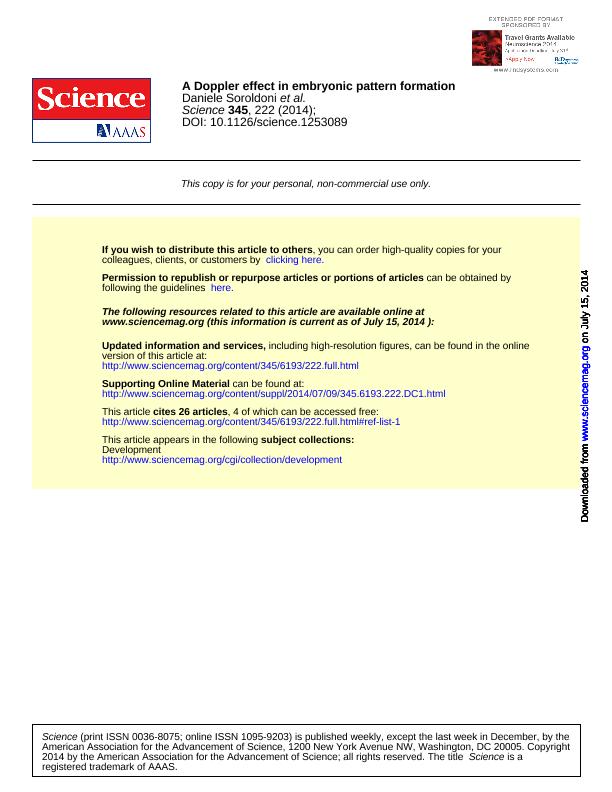Mostrar el registro sencillo del ítem
dc.contributor.author
Soroldoni, Daniele

dc.contributor.author
Jörg, David J.
dc.contributor.author
Morelli, Luis Guillermo

dc.contributor.author
Richmond, David L.
dc.contributor.author
Schindelin, Johannes
dc.contributor.author
Jülicher, Frank
dc.contributor.author
Oates, Andrew C.

dc.date.available
2017-12-01T16:02:07Z
dc.date.issued
2014-07
dc.identifier.citation
Soroldoni, Daniele; Jörg, David J.; Morelli, Luis Guillermo; Richmond, David L.; Schindelin, Johannes; et al.; A Doppler effect in embryonic pattern formation; American Association for the Advancement of Science; Science; 345; 6193; 7-2014; 222-225
dc.identifier.issn
0036-8075
dc.identifier.uri
http://hdl.handle.net/11336/29448
dc.description.abstract
During embryonic development, temporal and spatial cues are coordinated to generate a segmented body axis. In sequentially segmenting animals, the rhythm of segmentation is reported to be controlled by the time scale of genetic oscillations that periodically trigger new segment formation. However, we present real-time measurements of genetic oscillations in zebrafish embryos showing that their time scale is not sufficient to explain the temporal period of segmentation. A second time scale, the rate of tissue shortening, contributes to the period of segmentation through a Doppler effect. This contribution is modulated by a gradual change in the oscillation profile across the tissue. We conclude that the rhythm of segmentation is an emergent property controlled by the time scale of genetic oscillations, the change of oscillation profile, and tissue shortening.
dc.format
application/pdf
dc.language.iso
eng
dc.publisher
American Association for the Advancement of Science

dc.rights
info:eu-repo/semantics/openAccess
dc.rights.uri
https://creativecommons.org/licenses/by-nc-sa/2.5/ar/
dc.subject
Gene Expression Waves
dc.subject
Doppler Effect
dc.subject
Segmentation Clock
dc.subject
Clock And Wavefront
dc.subject.classification
Astronomía

dc.subject.classification
Ciencias Físicas

dc.subject.classification
CIENCIAS NATURALES Y EXACTAS

dc.subject.classification
Otras Ciencias Biológicas

dc.subject.classification
Ciencias Biológicas

dc.subject.classification
CIENCIAS NATURALES Y EXACTAS

dc.title
A Doppler effect in embryonic pattern formation
dc.type
info:eu-repo/semantics/article
dc.type
info:ar-repo/semantics/artículo
dc.type
info:eu-repo/semantics/publishedVersion
dc.date.updated
2017-06-12T18:04:53Z
dc.journal.volume
345
dc.journal.number
6193
dc.journal.pagination
222-225
dc.journal.pais
Estados Unidos

dc.description.fil
Fil: Soroldoni, Daniele. Max Planck Institute of Molecular Cell Biology and Genetics; Alemania. National Institute for Medical Research; Reino Unido
dc.description.fil
Fil: Jörg, David J.. Max Planck Institute for the Physics of Complex Systems; Alemania
dc.description.fil
Fil: Morelli, Luis Guillermo. Max Planck Institute of Molecular Cell Biology and Genetics; Alemania. Universidad de Buenos Aires. Facultad de Ciencias Exactas y Naturales. Departamento de Física; Argentina. Consejo Nacional de Investigaciones Científicas y Técnicas; Argentina
dc.description.fil
Fil: Richmond, David L.. Max Planck Institute of Molecular Cell Biology and Genetics; Alemania
dc.description.fil
Fil: Schindelin, Johannes. Max Planck Institute of Molecular Cell Biology and Genetics; Alemania. University of Wisconsin; Estados Unidos
dc.description.fil
Fil: Jülicher, Frank. Max Planck Institute for the Physics of Complex Systems; Alemania
dc.description.fil
Fil: Oates, Andrew C.. Max Planck Institute of Molecular Cell Biology and Genetics; Alemania. National Institute for Medical Research; Reino Unido
dc.journal.title
Science

dc.relation.alternativeid
info:eu-repo/semantics/altIdentifier/doi/http://dx.doi.org/10.1126/science.1253089
dc.relation.alternativeid
info:eu-repo/semantics/altIdentifier/url/http://science.sciencemag.org/content/345/6193/222
Archivos asociados
